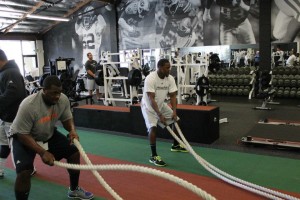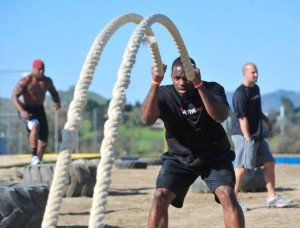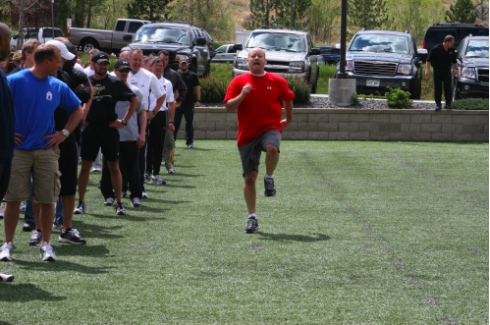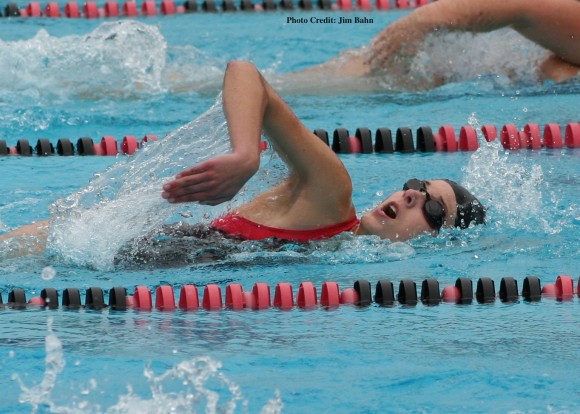 Ryan Capretta is a Certified Strength & Conditioning Specialist and the owner of Proactive Sports Performance (Proactive SP) in Southern California, a 5,000 square foot facility where he trains elite athletes including Clay Matthews, Antonio Cromartie, Nick Swisher, Dwight Freeney, and other exceptional athletes across the sports spectrum. He has coached four Super Bowl MVPs, one NBA finals MVP, more than 30 NFL Pro Bowlers, more than 20 NFL first round draft picks, and Olympic Gold Medalists. He worked as a strength and conditioning coach with the Baltimore Ravens, Stanford University, and the Arizona Cardinals before opening Proactive Sports Performance in 2005.
Ryan Capretta is a Certified Strength & Conditioning Specialist and the owner of Proactive Sports Performance (Proactive SP) in Southern California, a 5,000 square foot facility where he trains elite athletes including Clay Matthews, Antonio Cromartie, Nick Swisher, Dwight Freeney, and other exceptional athletes across the sports spectrum. He has coached four Super Bowl MVPs, one NBA finals MVP, more than 30 NFL Pro Bowlers, more than 20 NFL first round draft picks, and Olympic Gold Medalists. He worked as a strength and conditioning coach with the Baltimore Ravens, Stanford University, and the Arizona Cardinals before opening Proactive Sports Performance in 2005.
ATLX went head-to-head with Capretta on the training of elite athletes, his state of the art facility, and a veteran’s take on strength and conditioning.
ATLX: Okay Ryan, what sparked your interest in coaching and in strength and conditioning? When did you decide that was something you really wanted to do?
Capretta: Probably when I was a college athlete. I knew I wanted to be involved in sports and I had several injuries and some surgeries; my shoulder, my knees. And that kind of sparked my interest. Being an athlete and being hurt and trying to really understand how the process works, that’s where it started, when I was in college.
ATLX: What did you play in college?
Capretta: I played football. I was a receiver.
ATLX: And what sports do you train your athletes for?
Capretta: Oh, all kinds of sports. We have football, basketball, baseball, soccer, swimming, water polo, rugby, ice hockey, lacrosse, softball, skiing…
ATLX: A little bit of everything.
Capretta: Yeah, a little bit of everything. We had Lindsey Vonn. She’s an Olympic skier. She’s been coming in and that’s been fun for us, getting to know her and her training regimen. So a pretty wide variety of sports.
ATLX: Do you have a principle or a purpose that you base your training on at Proactive?
Capretta: We do. Mainly it’s individual improvement, following a progression and keeping a balance of exercises. Once we find what a certain individual’s weakness is, we like to focus on minimizing that imbalance or that weakness. And then from there we have a multifaceted approach to where we’re not focusing on just weightlifting or just running.
We try to integrate all of the different aspects of training, so obviously you have your strength and conditioning and your speed and quickness, but we also look, very very closely, at flexibility and power endurance. Those are things that we really focus a lot on. Most sports require you to be powerful, but we focus on how you can produce that power over the course of a couple reps, over the course of a first quarter, a second half.
So that’s a way that we really are a little different than most facilities. We don’t care how much you can one-rep max. It’s more about how you can be powerful when you’re fatigued in a real-world setting, like on the field or on the court or wherever that might be. How are you reacting when you’re fatigued?
ATLX: Now obviously, every athlete is different. You touched on that a little bit in your answer just now. But whether it’s their size, their performance, their ability or their motivation, you’re never training two different athletes the exact same way. So how does the focus of training change based on the athlete? For example, you’ll focus on different things with Dwight Freeney as opposed to Antonio Cromartie. What are some of the differences there?

Capretta: Well at first, it’s sport specific. And then within the sport, I look at position specifics. Cromartie is obviously going to have different needs than Freeney. And then the other thing that I take into consideration when dealing with professional athletes is their age. A guy like Derek Fisher who’s 38 years old, for example. I’m going to train him differently than a young NBA guy coming in at just 20 years old.
I’m always looking at joint safety and injury prevention not just from acute injuries, but from chronic injuries. There are a lot of injuries that occur over time and different adaptations that result from training. That’s the one thing that I’m always getting feedback on from these athletes, because everybody’s a little different. When I work with athletes who come to me later in their career, I need to have an understanding of their body. Not just my evaluation, but their feedback on what they’ve done in the past and how their body’s responded. It’s really important that I understand where their body is at currently and what they’ve done in the past, so I can see what’s worked for them and what hasn’t worked for them. So taking them through our evaluation and getting their feedback as well is really critical.
So I look at different sports and, within each sport, the different positions. So Dwight Freeney needs something, Cromartie needs something, and what those are will be different for each individual athlete. Even within the same position group of a sport, there are going to be different body types. There are going to be different injury backgrounds and history, the athletes are going to have different limitations and weaknesses, so it’s really dialed in depending on what that person is able to do and what they’re not able to do. And then I also look at the timeframes. Some of these athletes we have for two weeks, some of them we have for six months. There are a lot of variables that go into it.
ATLX: And are there any areas of training where the focus is standard across the board?
Capretta: Yes. Honestly I think there are more similarities than people realize. For instance, our basketball guys will be doing some of the football lifts that I do with our football guys, just with different variations. I have a philosophy that I stick to, some basic meat and potatoes that I feel everybody should be doing. It’s not so individualized and so sports specific that every single person is doing something different. There are some very key exercises that I feel will develop total body strength. For example, using the hips to fire the right muscles in the glutes while engaging the core. There are some similarities for sure.
ATLX: What about cardio and high intensity interval training?
Capretta: Now that really does dive into more sports specific training. Look at someone like Lindsey Vonn, who obviously has to have a lot of endurance for what she does. She’s on a total different cardio program than, say, Clay Matthews. But it all depends on the time of training. So there’s layout and progression that I follow to build a base, and then as it gets closer to the sport that they’re preparing for, it gets a lot more specific to the demands of that sport. And then even further specific to their individual position within that sport.
ATLX: What are some of the biggest obstacles that you face in training elite athletes, or obstacles that you see in athletes themselves?
Capretta: Let’s see. The biggest obstacle would be consistency. We tell all of our athletes, whether it’s a pro athlete or a high school athlete, that in order for this program and this training regimen to work, there needs to be consistency within training. They need to follow the training schedule that we lay out. When we get a pro athlete, they have a lot of things going on. They have commercial shoots or they have different engagements or they have to meet with their agents or their financial advisors. There’s a lot going on in their lives.
One guy who does not let that affect his training regimen is Clay Matthews. During last off-season, he had to go to New York to do a shoot for the NFL. He got back at 9:00 or 10:00 pm at night, and we were in the gym training at 11:00. That’s such a huge factor when an athlete at a high level understands the importance of a consistent training regimen.
ATLX: Speaking of consistency, and let’s switch sports here; when the off-season is over and Nick Swisher heads back to New York, are you still in contact with him? Or are you in contact with the Yankees strength and conditioning coach?
Capretta: I am. And it varies. There are some strength and conditioning coaches who are very open, since I’m on the private side, to making sure that their athlete is getting the best care and everything they need. Then there are some strength and conditioning coaches from the professional teams who really have no interest in working with outside personnel other than their own staff. But I am in contact with those individual athletes who we work with. If they need something extra outside of what their team is giving them, obviously I help them out on that side. So yeah, there is definitely good communication when they leave town.
ATLX: As a strength coach, what about the psychological side of training? The psychological side of the game? Do you see that as a common issue among the athletes?
Capretta: Yes. From a psychological standpoint, it’s a pretty easy thing for me to see where a person is at when I take them into a training program. Because, number one, there’s a lot of attention to detail. So I can see right off the bat if that athlete is focused and can soak in the information that I’m giving them. Number two is the mental toughness side. It’s easy for anybody to train hard and be excited about a program for two weeks, but once you get into the meat of the system and you’re having to really push through, that is when character shows.
And then it’s about the ability to train when it gets uncomfortable. What do you do when it gets uncomfortable? How do you respond? That’s something that, with the younger athletes, I really try to develop. With the older athletes, it takes its course. Some of the older athletes are going to continue to push themselves and I have to pull them off or they’ll over train. And then there are some of the older athletes who are going to do what they want to do no matter what I tell them. So it really just depends on the person you’re working with. But yeah, the psychological side is huge, for sure.
ATLX: And how do you help push these athletes to reach their potential?
Capretta: The best way I do that is by tracking their progress and recording their individual workout data. The best way to have them compete and give it their best effort is to show them what they did last time. I say, I don’t care what the other guy’s doing. I want to know about that last workout when you did this exact same exercise. Then I’m saying, hey, this is what you need to do today to improve from last week. And when we do that together week-to-week, month-to-month, for an entire off-season, that’s when we see some real results.
ATLX: Now in the off-season, how often and how long are these guys training with you?
Capretta: Well the football guys are training 11 times a week. They have 11 workouts per week. They’re training anywhere from three to four hours a day, six days a week.
ATLX: And what about during the baseball off-season?
Capretta: The baseball off-season is a little different because they spend so much time hitting and doing the other baseball-specific stuff that I don’t do with them. But typically, they’re training anywhere from four to five days a week for several hours a day.
ATLX: How much variety should there be in a strength and conditioning program?
Capretta: It depends on the athlete, the age, and the level they’re at. Variety can be a great thing or it can be a bad thing. In my opinion, there’s too much variety within training and there’s not enough consistency. So I try to create variety within our workouts and then we stick with those workouts. We consistently follow our plan so we can show the improvement. If you have too much variety and things are always changing, you cannot really track a true improvement. Yes, an athlete will improve but in terms of a documented plan that we’re following, it’s hard to justify and validate that improvement if there’s no consistency. So it’s kind of a hard question to answer, but there needs to be enough variety that I don’t lose the athlete and have stale workouts, but enough consistency to where we can follow our plan.
ATLX: And how important is recovery to making progress?
Capretta: Recovery is huge. I encourage them to spend some time with the physical therapist. I encourage them to see a masseuse. I encourage them to get their sleep, to get the proper nutrition, to do things like that. So yeah, if they can’t recover, they can’t train hard. And that’s what it’s all about.
ATLX: What would you say sets an elite athlete apart from an everyday athlete? Obviously athletic ability is a major factor, but besides that?
Capretta: Honestly, my first answer would be genetics. I’ve seen some athletes over the years who just have the best drive and the biggest heart and can train consistently and do everything, but they just don’t have the genetics. So ultimately, they’re not going to make it.
Aside from that though, it would be the ability to consistently work hard. So when they start the program in January or February, they are that same person in July without losing a step. And also keeping their focus. When you’re a professional athlete, you’ve got so many side things going on and sometimes people lose sight of the importance of what they’re doing in terms of how they prepare. So that’s why how they prepare and their consistency and their intensity are huge factors.
ATLX: What other roles do you play with your athletes? Obviously you are their coach, but these guys probably consider you a friend, family, someone they look up to. How do you find that balance with them?
Capretta: I think number one, I always establish that professional working environment first. So when they come in, I’m not trying to be their friend. There are a lot of people who, when they get around pro athletes, want to latch up with them and they want to tag along and see some benefits from that. My number one goal is to have them understand that I care about them as an individual in terms of their progression and their ultimate training environment. Part of that training environment is having them feel comfortable.
With athletes you’ve got people from so many different backgrounds, whether they come from the South or they’re a California person or they’re an East Coast person, or whatever they might be. That’s why I treat everybody similarly but I don’t treat everybody the same, because they all come from different backgrounds. Through my experience, I’ve come to understand how to relate to people. When I can relate to people and I can show them that I care about them as an individual, ultimately they’re going to trust me and work that much harder. So I have played the role of a friend, as a mentor, family, in addition to a coach and a trainer.
It varies, but the main thing is I’m not really trying to be their friend. Sometimes as you spend so much time with somebody, it inevitably evolves into that. It’s important to have the ability to first and foremost understand that when we’re training, there’s always that coach/athlete relationship regardless of how close we are. Once that friendship morphs over into and takes precedence over the coach/athlete relationship, I think I’m doing a disservice to the athlete.
ATLX: Right, that makes sense. And what about nutrition and injuries? Do you work with them on anything like that?
Capretta: I do. From a nutrition standpoint, we talk about consistency and the need to eat consistently throughout the day and not miss meals. We talk about pre-training and post-training. We have a BOD POD in our facility, so that allows me to take a very, very strict measure of where they’re at with their body composition. Everybody has different goals, so I can work with them pretty closely on how they get to those goals.
In terms of injuries, I work on injury prevention with exercises that aren’t traumatic to the joints. I try to strengthen an athlete without tearing down their joints and I also try to keep the body balance in terms of exercise selection. I focus on using the proper exercises to keep them healthy, but when I do have an athlete who needs acute care and physical therapy, I obviously have them work with the therapist. I have the athletes getting massages on a weekly basis as well.
ATLX: Could you walk me through a typical training session with one of your NFL guys?
Capretta: Definitely. Take preparing for training camp, for example. We’ll start in the weight room. When they’re in there, I’m doing full-body lifts with them. So they’ll come in and we’ll do a general warm-up and get their body going and get some body weight exercises in.
Then they’ll do some functional warm-up in terms of getting ready for that specific body part that they’re going to be working, but we really work the body as a whole. It’s not a bodybuilding workout, but before they go to do a heavy set of upper body work we’re going to get them lathered up and get a lot of blood flowing in the upper body so it’s prepared to go at a high intensity level. Then we do the same thing for the lower body.
We’ll typically do three rounds. The first round, depending on the time of year, will consist of anywhere from eight to 16 different exercises. Round two is when we really step up the intensity, and round three is all about finishing. So throughout these groups of exercises they’re going from one muscle group to the next, it’s fast paced, and there are built-in recoveries when they need them. I’m really pushing the pace the whole time and I’m tracking what that individual is doing and how it compares to their last workout.
ATLX: What about when you see your athletes achieve something truly great? When one of them reaches the Super Bowl or makes it to the NBA finals. How does that feel for you as their strength coach?
Capretta: Oh, it’s awesome. I’m very proud of them and it’s exciting for me because I’ve seen all the hard work that they’ve put in. But then on the flip side, I’m very careful not to take credit for that. Like when we talked about genetics, ultimately that’s going to be the number one determinant of their success. And there are so many other factors to making it to the Super Bowl, so I’m just excited for the individual and I’m root for them. It is an exciting thing for me and I’m very proud to have athletes like that, but I’m also very careful not to take the credit their success.
ATLX: If you could recommend some important areas of focus for an athlete hoping to take his game to the next level, what would they be?
Capretta: I would say it’s important to have some variety in your training. So if you’re a young athlete, don’t just focus on bench press and squat, and don’t just focus on getting strong and big, but also focus on your flexibility and your balance and your core strength and things like that. And then again, not to be a broken record, but consistency. Be the same person from one practice to the next. And learn from your coaches and your peers. Be a sponge and soak up as much information as you can.
ATLX: Would you say consistency is the most important thing to take into consideration when an athlete wants to get stronger?
Capretta: I would, yes.
ATLX: Ok we’ll wrap things up here, but lastly, are there any common misconceptions about strength and conditioning training that you want to set the record straight on? 
Capretta: Yes, absolutely. There are a few, but I’ll keep it basic. The main one is that people think they need to lift low reps and heavy, heavy weights to get strong and big. And especially when I’m dealing with younger athletes, that’s where I see a lot of injuries. So my biggest thing is teaching these young kids that they don’t need to squat and power clean and bench really, really heavy. They need to follow a proper technique and form and follow a progression, not just follow the meathead guy in the gym and do what he’s doing. They need to do what their individual body can handle.
See:
ATLX Expert: Ryan Capretta
ATLX Partner: Proactive Sports Performance
Proactive Sports Performance photo gallery
www.ProactiveSP.com
Want more ATLX exclusives? Follow us on Twitter and like us on Facebook.
 ATLX The only sports entertainment television and digital media network fully devoted to everyday athletes, athletic lifestyle and athletic culture.
ATLX The only sports entertainment television and digital media network fully devoted to everyday athletes, athletic lifestyle and athletic culture.







